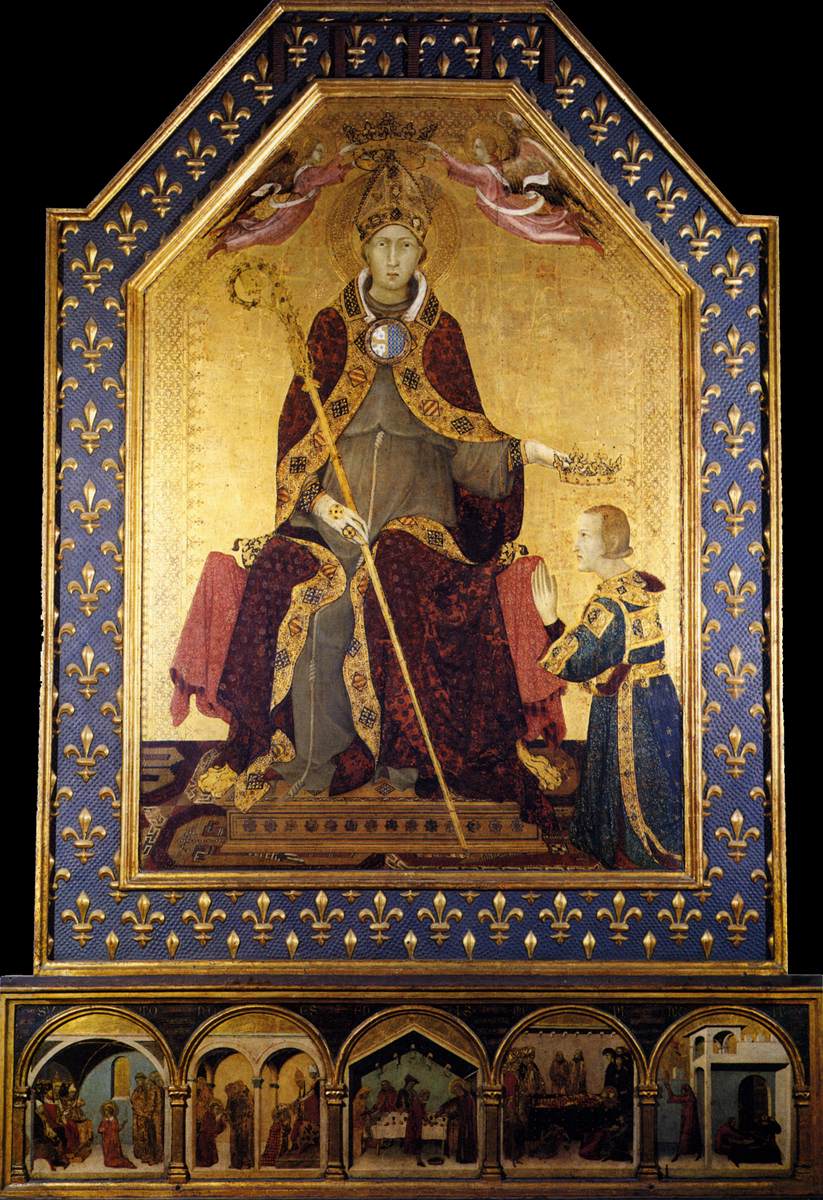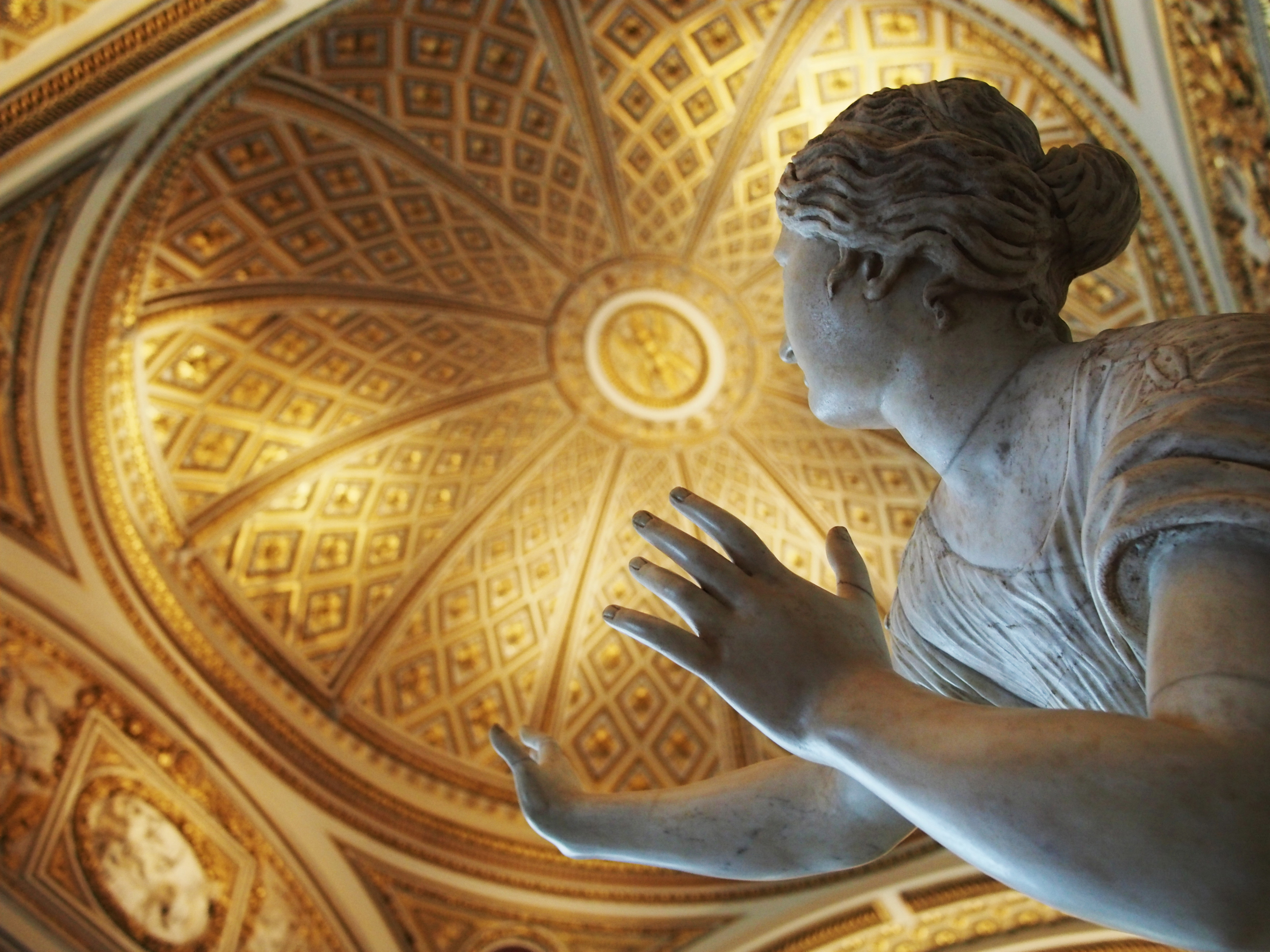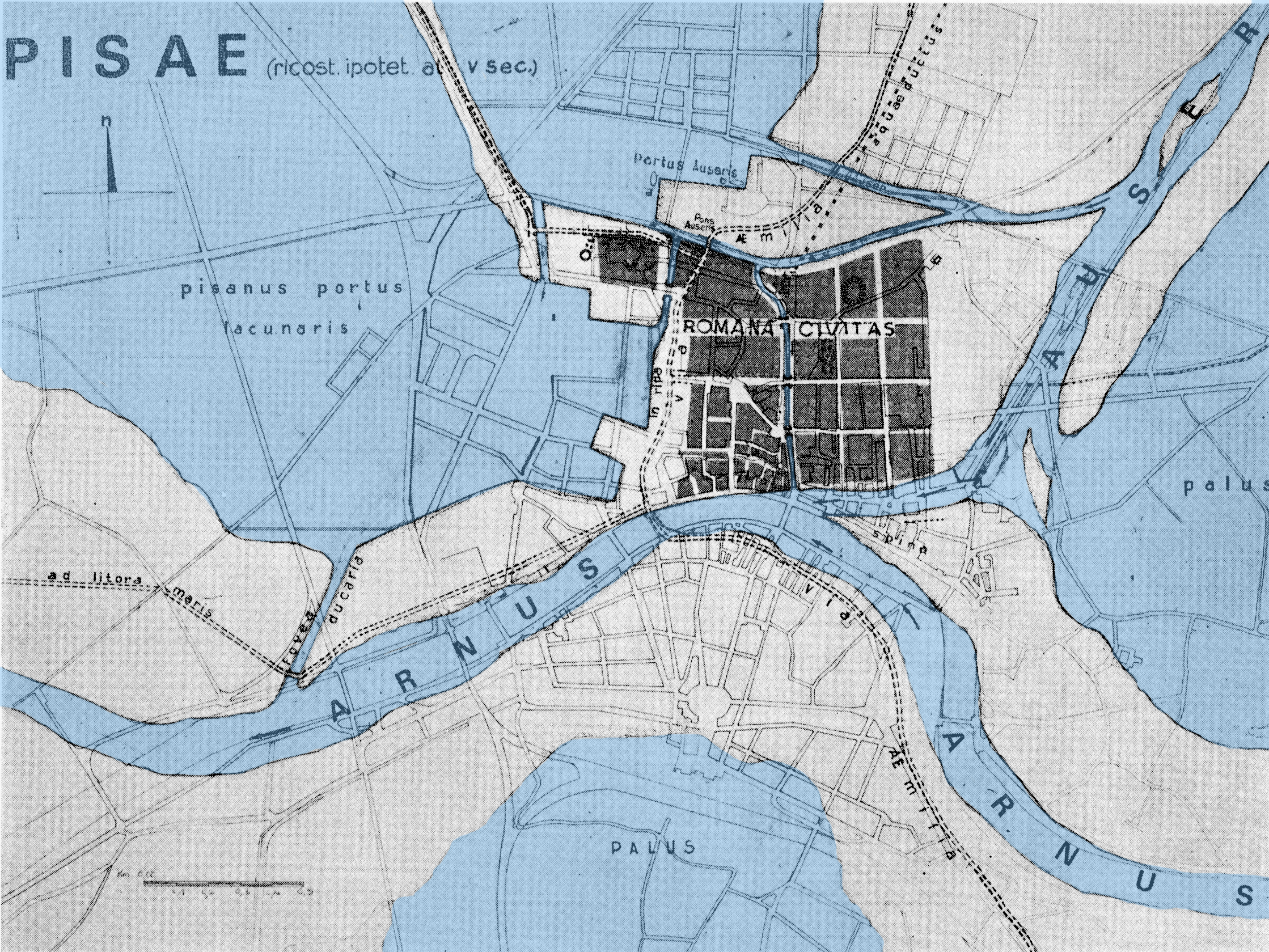|
Simone Martini
Simone Martini ( – July 1344) was an Italian painter born in Siena. He was a major figure in the development of early Italian painting and greatly influenced the development of the International Gothic style. It is thought that Martini was a pupil of Duccio di Buoninsegna, the leading Sienese painter of his time. According to late Renaissance art biographer Giorgio Vasari, Simone was instead a pupil of Giotto di Bondone, with whom he went to Rome to paint at the Old St. Peter's Basilica, Giotto also executing a mosaic there. Martini's brother-in-law was the artist Lippo Memmi. Very little documentation of Simone's life survives, and many attributions are debated by art historians. According to E. H. Gombrich, he was a friend of Petrarch and had painted a portrait of Laura. Biography Simone was doubtlessly apprenticed from an early age, as would have been the normal practice. Among his first documented works is the '' Maestà'' of 1315 in the Palazzo Pubblico in Siena. Lippo ... [...More Info...] [...Related Items...] OR: [Wikipedia] [Google] [Baidu] [Amazon] |
Saint Louis Of Toulouse Crowning His Brother Robert Of Anjou
''Saint Louis of Toulouse Crowning His Brother Robert of Anjou'' is a painting by Simone Martini, commissioned from him by Robert, King of Naples, Robert of Anjou during the artist's stay in Naples around 1317. It shows Robert being crowned by his elder brother Louis of Toulouse, who was made a saint in 1317. It is now in the National Museum of Capodimonte in Naples. References Bibliography *Pierluigi Leone de Castris, Simone Martini, Federico Motta Editore, Milano 2003. *Chiara Frugoni, Le storie di San Francesco. Guida agli affreschi della Basilica superiore di Assisi, Einaudi, 2010. *P. de Rynck, Simone Martini: «San Luis de Toulouse coronando a Roberto de Anjou, rey de Nápoles», pp. 12–13, Random House Mondadori (2005) *Center and Periphery: Studies on Power in the Medieval World in Honor of William Chester Jordan *Holy Rulers and Blessed Princesses: Dynastic Cults in Medieval Central Europe {{14C-painting-stub 1310s paintings Paintings in the Museo di Capodimo ... [...More Info...] [...Related Items...] OR: [Wikipedia] [Google] [Baidu] [Amazon] |
Petrarch
Francis Petrarch (; 20 July 1304 – 19 July 1374; ; modern ), born Francesco di Petracco, was a scholar from Arezzo and poet of the early Italian Renaissance, as well as one of the earliest Renaissance humanism, humanists. Petrarch's rediscovery of Cicero's letters is often credited with initiating the 14th-century Italian Renaissance and the founding of Renaissance humanism. In the 16th century, Pietro Bembo created the model for the modern Italian language based on Petrarch's works, as well as those of Giovanni Boccaccio, and, to a lesser extent, Dante Alighieri. Petrarch was later endorsed as a model for Italian style by the . Petrarch's sonnets were admired and imitated throughout Europe during the Renaissance and became a model for lyrical poetry. He is also known for being the first to develop the concept of the "Dark Ages (historiography), Dark Ages". [...More Info...] [...Related Items...] OR: [Wikipedia] [Google] [Baidu] [Amazon] |
San Gimignano
San Gimignano (; named after St. Geminianus) is a small walled medieval hill town in the province of Siena, Tuscany, north-central Italy. Known as the Town of Five Towers, San Gimignano is famous for its medieval architecture, unique in the preservation of about a dozen of its tower houses, which, with its hilltop setting and encircling walls, form "an unforgettable skyline". Within the walls, the well-preserved buildings include notable examples of both Romanesque and Gothic architecture, with outstanding examples of secular buildings as well as churches. The Palazzo Comunale, the Collegiata and Church of Sant' Agostino contain frescos, including cycles dating from the 14th and 15th centuries. The "Historic Centre of San Gimignano" is a UNESCO World Heritage Site. The town also is known for saffron, the dry aged and saffron infused ''Golden Ham'', pecorino cheese and its white wine, Vernaccia di San Gimignano, produced from the ancient variety of Vernaccia grape grown o ... [...More Info...] [...Related Items...] OR: [Wikipedia] [Google] [Baidu] [Amazon] |
Avignon Cathedral
Avignon Cathedral ( French: ''Cathédrale Notre-Dame des Doms d'Avignon'') is a Roman Catholic church located next to the Palais des Papes in Avignon, France. The cathedral is the seat of the Archbishop of Avignon. The cathedral is a Romanesque building, constructed primarily in the second half of the 12th century. The bell tower collapsed in 1405 and was rebuilt in 1425. In 1670–1672 the apse was rebuilt and extended. The extension led to the destruction of the medieval cloister. The building was abandoned and allowed to deteriorate during the Revolution, but it was reconsecrated in 1822 and restored by the archbishop Célestin Dupont in 1835–1842. The most prominent feature of the cathedral is a gilded statue of the Virgin Mary atop the bell tower which was erected in 1859. The interior contains many works of art. The most famous of these is the mausoleum of Pope John XXII (died 1334), a 14th-century Gothic edifice. It was moved in 1759, damaged during the Revolution, a ... [...More Info...] [...Related Items...] OR: [Wikipedia] [Google] [Baidu] [Amazon] |
Basilica Of San Francesco D'Assisi
The Basilica of Saint Francis of Assisi (; ) is the mother church of the Roman Catholic Order of Friars Minor Conventual in Assisi, a town in the Umbria region in central Italy, where Francis of Assisi, Saint Francis was born and died. It is a papal minor basilica and one of the most important places of Christian pilgrimage in Italy. With its accompanying friary, Sacro Convento, the basilica is a distinctive landmark to those approaching Assisi. It has been a UNESCO World Heritage Site since 2000. The basilica, which was begun in 1228, is built into the side of a hill and comprises two churches (known as the Upper Church and the Lower Church) and a crypt, where the remains of the saint are interred. The interior of the Upper Church is an important early example of the Gothic architecture, Gothic style in Italy. The Upper and Lower Churches are decorated with frescoes by numerous Late Middle Ages, late medieval painters from the Roman and Tuscan schools, and include works by Cimabu ... [...More Info...] [...Related Items...] OR: [Wikipedia] [Google] [Baidu] [Amazon] |
Chapel Of St
A chapel (from , a diminutive of ''cappa'', meaning "little cape") is a Christian place of prayer and worship that is usually relatively small. The term has several meanings. First, smaller spaces inside a church that have their own altar are often called chapels; the Lady chapel is a common type of these. Second, a chapel is a place of worship, sometimes interfaith, that is part of a building, complex, or vessel with some other main purpose, such as a school, college, hospital, palace or large aristocratic house, castle, barracks, prison, funeral home, hotel, airport, or military or commercial ship. Third, chapels are small places of worship, built as satellite sites by a church or monastery, for example in remote areas; these are often called a chapel of ease. A feature of all these types is that often no clergy are permanently resident or specifically attached to the chapel. For historical reasons, ''chapel'' is also often the term used by independent or nonconformist den ... [...More Info...] [...Related Items...] OR: [Wikipedia] [Google] [Baidu] [Amazon] |
Uffizi
The Uffizi Gallery ( ; , ) is a prominent art museum adjacent to the Piazza della Signoria in the Historic Centre of Florence in the region of Tuscany, Italy. One of the most important Italian museums and the most visited, it is also one of the largest and best-known in the world and holds a collection of priceless works, particularly from the period of the Italian Renaissance painting, Italian Renaissance. After the ruling House of Medici died out, their art collections were given to the city of Florence under the famous ''Patto di famiglia'' negotiated by Anna Maria Luisa de' Medici, Anna Maria Luisa, the last Medici heiress. The Uffizi is one of the first modern museums. The gallery had been open to visitors by request since the sixteenth century, and in 1769 it was officially opened to the public, formally becoming a museum in 1865. History The building of the Uffizi complex was begun by Giorgio Vasari in 1560 for Cosimo I de' Medici, Grand Duke of Tuscany, Cosimo I de' M ... [...More Info...] [...Related Items...] OR: [Wikipedia] [Google] [Baidu] [Amazon] |
Pisa
Pisa ( ; ) is a city and ''comune'' (municipality) in Tuscany, Central Italy, straddling the Arno just before it empties into the Ligurian Sea. It is the capital city of the Province of Pisa. Although Pisa is known worldwide for the Leaning Tower of Pisa, the city contains more than twenty other historic churches, several medieval palaces, and bridges across the Arno. Much of the city's architecture was financed from its history as one of the Italian maritime republics. The city is also home to the University of Pisa, which has a history going back to the 12th century, the Scuola Normale Superiore di Pisa, founded by Napoleon in 1810, and its offshoot, the Sant'Anna School of Advanced Studies.Scuola Superiore Sant'Anna di Pisa Information statistics History ...
|
Saint Catherine Of Alexandria Polyptych
The ''Saint Catherine of Alexandria Polyptych'' (also known as Pisa Polyptych) is a painting by the Italian medieval artist Simone Martini, dating to 1320. Originally placed at the high altar of the church of Santa Caterina, Pisa, it is now housed in the Museo Nazionale di San Matteo of the same city. The work is signed SYMON DE SENIS ME PINXIT in the central panel with the ''Madonna and Child''. According to the original convent's annals, the polyptych was placed at the altar in 1320. It was thus completed by that year, having been likely begun in 1319. Description The polyptych is Martini's largest work, and includes numerous sub-panels. The altarpiece consists of seven main elements, each one in three parts: a cusp, a smaller panel divided into two sections, and a larger panel depicting a single saint. There is also a predella consisting of seven smaller size panels. There are 15 predella In art a predella (plural predelle) is the lowest part of an altarpiece, sometimes ... [...More Info...] [...Related Items...] OR: [Wikipedia] [Google] [Baidu] [Amazon] |
Stefanone
Stefanone (active c. 1350 – c. 1390) was an Italian painter of the Trecento, active in Naples. Biography We have few details of Stefanone but for what is said of him by Bernardo de' Dominici in his biography of Neapolitan painters. He is believed to have trained along with Gennaro di Cola under Simone Martini Simone Martini ( – July 1344) was an Italian painter born in Siena. He was a major figure in the development of early Italian painting and greatly influenced the development of the International Gothic style. It is thought that Martini was a p .... He painted a ''San Lodovico vescovo di Tolosa'', begun by Simone. volume 3, by Stefano Ticozzi, page 369. References [...More Info...] [...Related Items...] OR: [Wikipedia] [Google] [Baidu] [Amazon] |
Gennaro Di Cola
Gennaro di Cola (c. 1320 – c. 1370) was an Italian painter of the Trecento, active mainly in Naples. He trained with Simone Martini, and reportedly befriended Giotto. He worked in fresco alongside his pupil Stefanone. His frescoes of the testament scenes in the church of San Giovanni a Carbonara San Giovanni a Carbonara is a Gothic church in Naples, Southern Italy Southern Italy (, , or , ; ; ), also known as () or (; ; ; ), is a macroregion of Italy consisting of its southern Regions of Italy, regions. The term "" today mostly ... have been lost. In Santa Maria della Pietà, he painted the ''Mater Dolorosa with dead body of Christ''. References * 1320s births 1370 deaths 14th-century Italian painters Italian male painters Trecento painters Painters from Naples {{Italy-painter-14thC-stub ... [...More Info...] [...Related Items...] OR: [Wikipedia] [Google] [Baidu] [Amazon] |
Museo Di Capodimonte
Museo di Capodimonte is an art museum located in the Palace of Capodimonte, a grand Bourbon palazzo in Naples, Italy designed by Giovanni Antonio Medrano. The museum is the prime repository of Neapolitan painting and decorative art, with several important works from other Italian schools of painting, and some important ancient Roman sculptures. It is one of the list of largest art museums, largest museums in Italy. The museum was inaugurated in 1957. History The vast collection at the museum traces its origins back to 1738. During that year King Charles VII of Naples and Sicily (later Charles III of Spain) decided to build a hunting lodge on the Capodimonte hill, but then decided that he would instead build a grand palace, partly because his existing residence, the Palace of Portici, was too small to accommodate his court, and partly because he needed somewhere to house the fabulous Farnese Collection which he had inherited from his mother, Elisabetta Farnese, last de ... [...More Info...] [...Related Items...] OR: [Wikipedia] [Google] [Baidu] [Amazon] |






